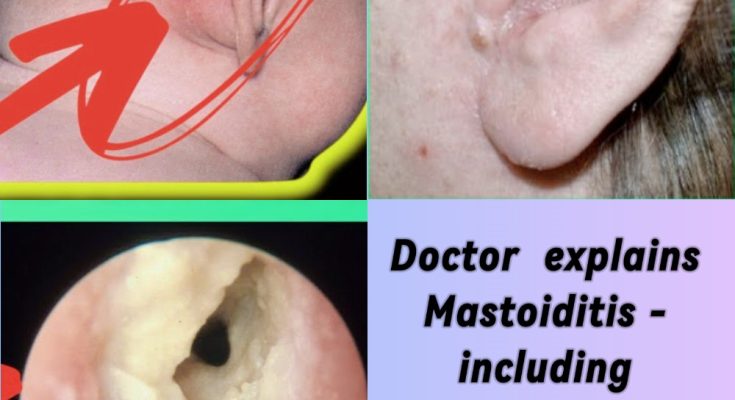Mastoiditis is a serious bacterial infection that affects the mastoid bone, which is located just behind the ear.1 It’s a complication that can arise from an untreated or poorly treated middle ear infection (otitis media).2 While less common today due to widespread antibiotic use, it’s crucial to understand its anatomy, symptoms, diagnosis, and treatment to prevent severe complications.3
1. Anatomy of the Mastoid Bone
The mastoid process is a prominent, cone-shaped bony projection of the temporal bone, one of the bones that form the side and base of the skull.4 You can feel it as a hard bump behind your earlobe.
Inside the mastoid process are many small, air-filled spaces called mastoid air cells.5 These cells are lined with mucous membranes and are continuous with the middle ear cavity.6 This connection is why infections from the middle ear can easily spread into the mastoid bone.
The mastoid bone plays several roles:
- It provides an attachment point for several muscles of the head and neck, including the sternocleidomastoid muscle.7
- The mastoid air cells are thought to help protect the delicate structures of the ear and regulate ear pressure.8
- Its porous, honeycomb-like structure, while allowing for air circulation, also makes it susceptible to infection once bacteria gain entry, as the infection can spread through these tiny spaces.9
2. Symptoms
The symptoms of mastoiditis typically appear days to weeks after an acute middle ear infection develops. They can range from mild to severe and often include:
- Pain, tenderness, and swelling behind the ear: This is a hallmark symptom. The area may feel warm to the touch.
- Redness (erythema) behind the ear: The skin over the mastoid bone may become noticeably red.10Protrusion of the ear: The affected ear may appear to stick out further from the head due to swelling behind it.1
- Ear pain (otalgia): Persistent and throbbing earache.
- Discharge from the ear: Pus or other fluid may drain from the ear.12
- Fever: Often a high temperature, sometimes with chills.13
- Headache: Can be severe.
- Hearing loss: In the affected ear.14
- Irritability and tiredness: Especially in children.15
- Loss of appetite: More common in infants.
In very young children, symptoms might be less specific, such as fussiness, lethargy, or pulling at the ear.16
If left untreated, mastoiditis can lead to serious complications as the infection spreads:17
- Abscess formation: Collections of pus can form within the mastoid bone (coalescent mastoiditis), under the skin behind the ear (subperiosteal abscess), or even deeper in the neck (Bezold’s abscess).
- Facial nerve paralysis: The facial nerve (cranial nerve VII) runs close to the mastoid bone, and inflammation or an abscess can compress it, leading to weakness or paralysis of facial muscles on the affected side.
- Labyrinthitis: Spread of infection to the inner ear, causing dizziness (vertigo) and ringing in the ears (tinnitus).18
- Intracranial complications: The most serious, though rare, complications involve the spread of infection to the brain or its surrounding structures, including:
- Meningitis (inflammation of the membranes surrounding the brain and spinal cord)19
- Brain abscess (a collection of pus within the brain tissue)20
- Epidural or subdural abscesses (pus collections between the skull and the brain’s outer membrane)21
- Venous sinus thrombosis (blood clot in the brain’s veins)22
- Hearing loss: Permanent hearing loss can occur if the infection severely damages the middle or inner ear structures.23
3. Diagnosis
Early diagnosis is crucial to prevent serious complications.24 Your doctor will typically
- Take a thorough medical history: Asking about recent ear infections, symptoms, and their progression.
- Perform a physical examination: This includes examining the ear with an otoscope to look for signs of a middle ear infection or cholesteatoma (an abnormal skin growth in the ear that can also cause mastoiditis).25 The area behind the ear will be inspected for redness, swelling, tenderness, and any ear protrusion.26
- Imaging tests:
- CT scan of the ear or head: This is the most common and definitive imaging test. It provides detailed images of the mastoid bone, showing fluid accumulation, bone destruction, and any abscesses, helping to determine the extent of the infection.27
- MRI scan: May be used if intracranial complications are suspected.28
- Blood tests: To check for signs of infection or inflammation, such as an elevated white blood cell count (CBC) or inflammatory markers (ESR, CRP).29
- Ear culture: If there is any discharge from the ear, a sample may be taken and sent to a lab to identify the specific bacteria causing the infection.30 This helps guide antibiotic treatment. If no spontaneous drainage occurs, a myringotomy (a small incision in the eardrum) may be performed to obtain fluid for culture.
4. Treatment
Mastoiditis is a serious infection that requires prompt and aggressive treatment, usually in a hospital setting.31
- Antibiotics:
- Intravenous (IV) antibiotics: This is the primary treatment. High-dose antibiotics are given directly into a vein to quickly fight the infection throughout the body.32 Patients typically stay in the hospital for a few days to ensure the antibiotics are working.33
- Oral antibiotics: Once the acute infection is controlled and symptoms improve, you may be discharged with a course of oral antibiotics to complete at home. It’s vital to finish the entire course, even if you feel better, to prevent recurrence and antibiotic resistance.34
- The choice of antibiotic will depend on the bacteria identified from a culture, if available. Common culprits include Streptococcus pneumoniae, Haemophilus influenzae, and Staphylococcus aureus.35
- Drainage procedures (if necessary):
- Myringotomy: A small incision is made in the eardrum to drain fluid and pus from the middle ear and mastoid cavity. Sometimes, a small tube (tympanostomy tube or “grommet”) is inserted into the eardrum to keep the hole open and allow for continued drainage.36 This also helps relieve pressure.
- Mastoidectomy: If antibiotic treatment alone is not effective, if an abscess has formed, or if there’s significant bone destruction, surgery to remove part of the infected mastoid bone (mastoidectomy) may be necessary.37 This procedure aims to clear the infection and prevent its spread to critical structures.38 The extent of the surgery depends on the severity of the infection.
Post-treatment Care and Prevention:
- Follow-up: Regular follow-up appointments with an ENT (Ear, Nose, and Throat) specialist are crucial to monitor healing and ensure the infection has fully cleared.39
- Protect the ear: You may be advised to keep the affected ear dry for a period, especially after surgery.
- Preventing ear infections: The best way to prevent mastoiditis is to promptly and effectively treat any middle ear infections.40 If your child frequently gets ear infections, discuss preventive measures with your doctor.
With timely and appropriate treatment, mastoiditis can be cured, and most people recover without long-term complications.41 However, delays in diagnosis and treatment can lead to severe and potentially life-threatening outcomes. If you suspect mastoiditis, seek immediate medical attention.



